Forklift rules and regulations: rollover of forklifts, safety regulations, accidents in storage, maneuvers, collisions with shelves in warehouses.
Personal safety measures are also essential for working with machinery in different types of warehouses.
Whether handling staves, various stackers or powerful forklifts, it is recommended that operators and workers have gloves and helmets at all times to reduce risks in their work. In addition, all protection accessories must be in perfect condition.

Forklift safety rules
Forklift Operation Safety: What are the risks when working with forklifts?
Forklifts are one of the main sources of accidents worldwide in warehouses or industrial warehouses. When using forklifts, certain precautions must be taken to prevent accidents.
Forklift Operation Safety: Different forklifts = different precautions
There are two different types of forklifts, those driven electrically by batteries and those of engines, powered by liquefied gas, diesel or natural gas tanks.
Regardless of which of these models of forklifts count, both types have different particular conditions of operation, which must be respected and checked daily.
Electrical equipment can present risks if the operator does not know how to handle batteries when they are at the limit of exhaustion.
On the other hand, gas equipment has tanks that must be refilled and changed. The oil and the condition of the covers must be controlled in any of the two cases of forklifts.
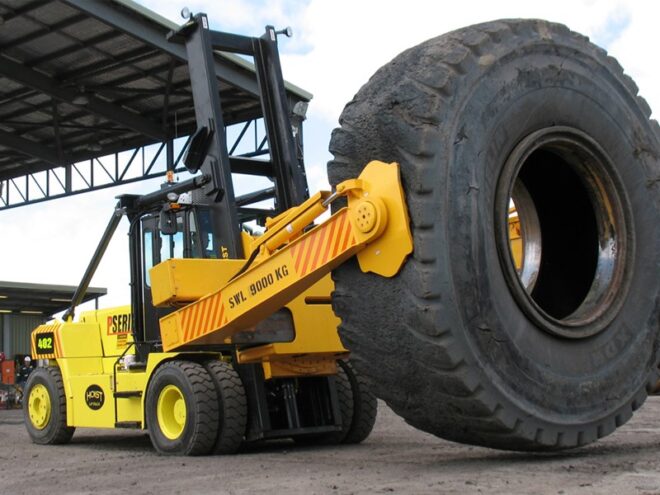
Forklift safety training
Forklift Operation Safety: Risks when working with forklifts. Forklift Operation Safety: Dangers when operating a forklift.
Below, the most common accidents with forklifts are detailed, so that appropriate measures can be taken to prevent them.
- A maximum speed of a forklift
- Distance between forklifts and pedestrian
- Blind spots of a forklift
- Forklift overturning
- Forklift accidents in warehouses
Warehouse forklift safety
Among the most common risks for this type of accident are excess speed and poor traction in curves, being the forklifts prone to tilting and tipping.
In order to avoid this type of accident, a warehouse or warehouse must be well signposted and all personnel including operators instructed on the primary safety standards.
Forklift pedestrian safety
Forklift Operation Safety: Distance between forklifts and pedestrians:
Passers-by in transit areas: Moving inside a warehouse in the same spaces where forklifts are driven is not the most appropriate.
The pedestrian corridors must be defined rigorously, as well as be signposted.
This will prevent forklift operators from having to be aware of whether someone can walk by.
These types of accidents can end with a person injured by the nail of the vehicle or another part, for example.
The personnel that transits in the corridors where they also circulate forklifts must wear vests of fluorescent colors, helmet, and safety boots.
In this way, it will be visible at long distances by the drivers.
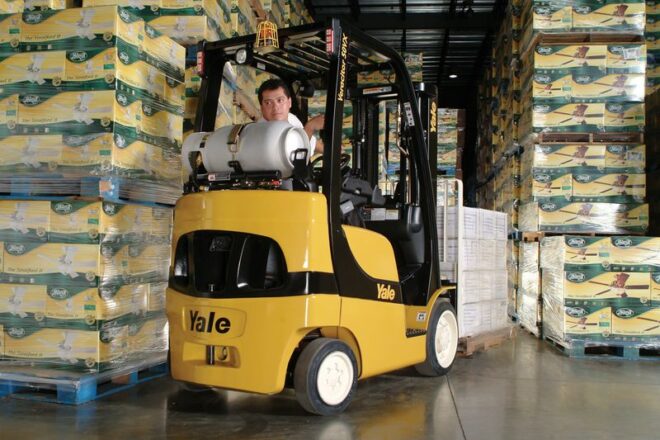
Warehouse Forklift
Accidents in warehouses; These accidents are due to a lack of control of the daily state of the forklift by the personnel in charge of the deposit.
A daily review of the condition of the forklifts should be made and, in this way, ensure the proper functioning of the equipment.
The forklift inspection should be done at the beginning and end of the shift, to ensure that the equipment is working properly and can be operated safely by the following personnel. The forklift cannot be used until a supervisor reviews it in case of finding anomalies.
Forklift accident
Causes of overturning of forklifts:
- Unawareness of the maximum load capacity
- It is necessary for each driver to know the capacity of his vehicle and its accessories, and not exceed it.
- An overload causes rear tire lift and excessive tilt, plus further damage to the vehicle or personnel.
- The maximum load capacity of any forklift must be identified, being clear of the maximum weight that can be loaded with it.
- This can be checked in the technical specifications of the manufacturers.
In case of not have the technical sheet at hand, you can search the equipment with the technical data and the maximum capacity.
Once this information is known, the personnel in charge of operating the equipment should be informed.
This small training helps us to avoid using excessive load when driving the forklift, which can end up causing an accident.
Uses of forklifts
Forklift Operation Safety:
- The nails should be used only for their purpose, lifting loads.
- The tip of the nails should not be used as a lever, just as it is not correct to push a load with the tips of the nails.
- The hoists, in addition, must be used depending on whether they are for exteriors or interiors.
For example, using a vehicle for outdoor interiors with excessively stony or muddy roads can cause permanent damage to the chassis or forklift covers.
The load should be made only in special places. Another important fact is to switch off the forklift engine before refilling it with fuel or charging its battery.
Forklift operator training
Forklift Operation Safety: What are the risk factors of a forklift operator?
The forklift or forklift is used for transporting loads only. The operator must not allow his companions to climb unless another seat is insured.
If a person must be elevated to perform product review tasks such as cyclic counts or maintenance tasks, it is necessary to use an adequate security platform.
Thus, verify that it is correctly secured to the forklift with chains or padlocks. In addition, a harness should be used as a safety measure in case of incidents.
Do not authorize anyone to stand or walk under a load transported by the forklift.
Forklift operator
Forklift Operation Safety: Driving forklift, When a forklift is performing loading or unloading drive, there should be no personnel near the place.
It is the responsibility of the operators to avoid this type of unsafe maneuver, but also the nearby personnel must remember not to approach.
In addition, it is important to make sure that the drivers’ clothes are not loose to prevent them from getting stuck in the machinery.
They should also avoid operating the controls with their hands stained with grease because they can cause bad handling and a subsequent accident.
If you take into account the causes that can determine these types of accidents, and make appropriate use of the forklift it will have an excellent useful life and there will be no accidents during your operation.
Forklift safety tips
Forklift Operation Safety: Safety rules for operating forklifts.
If all these precautions are taken into account, the chances of accidents at work and waste of materials will be minimized.
- Never carry a load that requires another employee to physically stabilize the load while moving the forklift.
- Never carry a load that exceeds the maximum capacity of the forklift.
- One sign of a heavy load is that the rear wheels rise when the load begins to rise.
- In these cases, lower the load immediately and change the lifting equipment or reduce the weight of the load.
- To maximize stability, the load must be hooked and centered on the forklift nails.
- The load should be supported against the back or vertical part of the nails.
- In addition, the length of the nails should always be of the length of the load, or greater.
- To prevent the load from tilting forward, the forklift mast must be tilted backward.
- If necessary, separate the nails before lifting the load.
- As a general rule, the wider, the better.

Forklift rules and regulations
Forklifts Operation Safety: Floor marking systems.
Implement a Floor Marking System to Keep Workers Safe: OSHA maintains basic rules and regulations for effective floor marking. Part of the agency’s standard for walking and working surfaces, states: “Permanent aisles and passageways shall be appropriately marked.” The broader standard sets no guideline for floor marking colors unless floor marking is used for preventing physical injuries.
That said, the agency’s standard for outlining safety color codes—mentions that red and yellow are designated safety color codes for marking physical hazards.
- Red is for fire-related hazards (including the identification of fire protection equipment and containers of flammable liquids), as well as emergency switches, bars, and buttons on hazardous machines.
- Yellow designates caution and is used to mark physical hazards (including stumbling, falling, and “caught in-between”).
Visual communication systems
Develop a Visual Communication System: Here are a few tips for successful visual communication, which can alert operators and pedestrians to hazards caused by forklifts:
- Use “Stop” signs, speed limit signs, and other traffic control devices
- Implement wayfinding to improve the flow of traffic, keep pedestrians away from forklift paths, and direct forklifts along safe routes
- Point out loading docks, shelves for inventory, and other important places within a warehouse
- Post signs at junctions to warn pedestrians and forklift operators to stop and look for hazards
- Display checklists and inspection requirements where forklifts are stored
Safety communication
Implement Solutions for Forklift Safety: Many of the hazards posed by forklifts can be mitigated with custom signage and clear visual communication. DuraLabel industrial printers by Graphic Products help you create custom signs on demand, including speed limit signs, printed floor marking tape, maintenance labels, safety reminders, and more.
Worker safety
Keep An Eye Out Around Your Facility: Even if you’re not operating a forklift, you can take steps to keep workers safe. Here are a few tips to keep in mind:
- Post forklift safety signs, aisle markers, and forklift procedure labels—using premade signs, custom labels, or a combination of the two
- Implement a floor marking system in your facility
- Ensure safety signs are at all intersections where pedestrians and vehicles intersect
- Use steering wheel covers and padlocks when necessary
- Use proper lockout/Tagout equipment to prevent forklifts from inadvertently starting up.
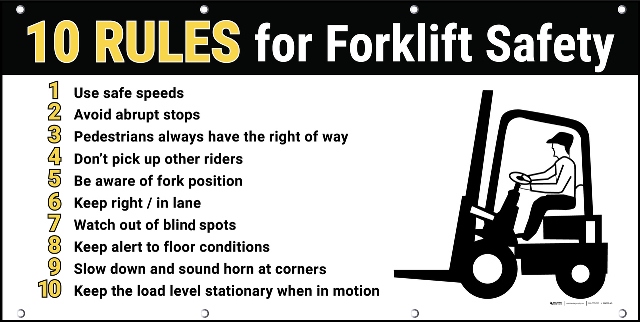
Workplace safety
Stay Safe While Using A Forklift: Workers should do the following while behind the wheel to protect themselves and their coworkers:
- Make sure the load is balanced and fully secure to prevent a forklift from tipping over
- Ensure both forks are as far under the load as possible before lifting
- Drive with the load as low as safely possible
- Pay attention to posted speed limits and warning signs
- Always look in the direction you’re traveling; if a load blocks the view ahead, travel in reverse
- Steer clear of areas where forklifts are prohibited or restricted
- Keep an eye out for signs, floor markings, and other warnings for pedestrians and forklifts
- Use the horn at intersections and in areas where pedestrians may be present
Forklift classes
Know the Forklift Classes: These are classifications of six commonly-used types of forklifts, as recognized by OSHA, along with different types of trucks unique to each class.
- Electric Motor Rider Trucks
- Rough Terrain Forklift Trucks
- Electric Motor Narrow Aisle Trucks
- Electric Motor Hand Trucks or Hand/Rider Trucks
- Internal Combustion Engine Trucks with Solid/Cushion Tires
- Internal Combustion Engine Trucks with Pneumatic Tires
- Electrical and Internal Combustion Engine Tractors
- Rough Terrain Forklift
Health and safety hazards
Know the Common Hazards: Here’s a quick look at a few common hazards associated with forklifts.
- Unsecured loads may fall, crushing pedestrians or drivers.
- Forklifts may tip over, due to excessive speed or imbalanced loads
- Workers may fall if they stand on the forks
- Drivers may not see pedestrians, leading to collisions and fatal accidents
- Improper or missing floor marking may lead to accidents between forklifts and pedestrians
Forklift Operation Safety
According to OSHA, 70 percent of workplace accidents can be avoided with proper training and safety procedures.
NIOSH states that the three most common types of injuries occur when: A forklift overturns; workers are struck, crushed, or pinned by a forklift; and workers fall from a forklift.
The average hourly pay for all forklift drivers is around $15 per hour but will vary by experience and location. Skill level is the biggest differentiator in pay. The longer you’ve been on the job, the closer you’ll get to that $20 per hour mark.
The short answer is “yes” – it is necessary to hold a license to operate a forklift. However, if you are “in training” you are permitted to operate a forklift without a license until such time as you are competent enough to be assessed. You must be within sight and sound of a licensed operator at all times.
The Top Causes of Forklift Tip-Overs. During a forklift tip-over, the lift truck will usually tip over forward or to the side. Tip-overs in both directions usually happen for different reasons. The lateral tip-over (sideways) often occurs when the driver is crossing from a paved surface to an even surface.
There are many other possible hazards of a particular work environment that might cause a forklift accident. These include pits or openings in the floor, congested or narrow workspaces, and the presence of flammable and combustible material.
Never refuel while the engine is running (the engine has the potential to ignite the fuel) Ensure you are following safe parking procedures. Open flame, smoke and any potential source of ignition are prohibited within 10 meters of any truck being refueled or recharged.
The most read
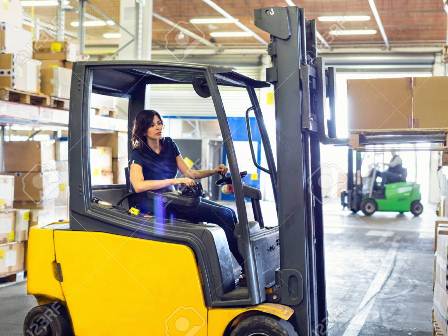
Forklift Safety Procedures
Forklifts can be dangerous, they account for 25% of injuries at work.
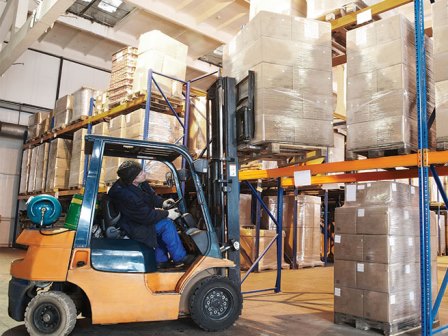
Forklift Operator Responsibilities
There are many different ways to operate a forklift.
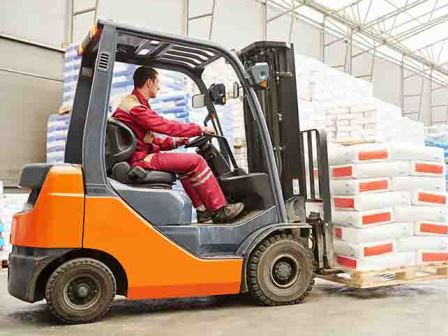
How to drive a Forklift?
How to drive a forklift for beginners?
